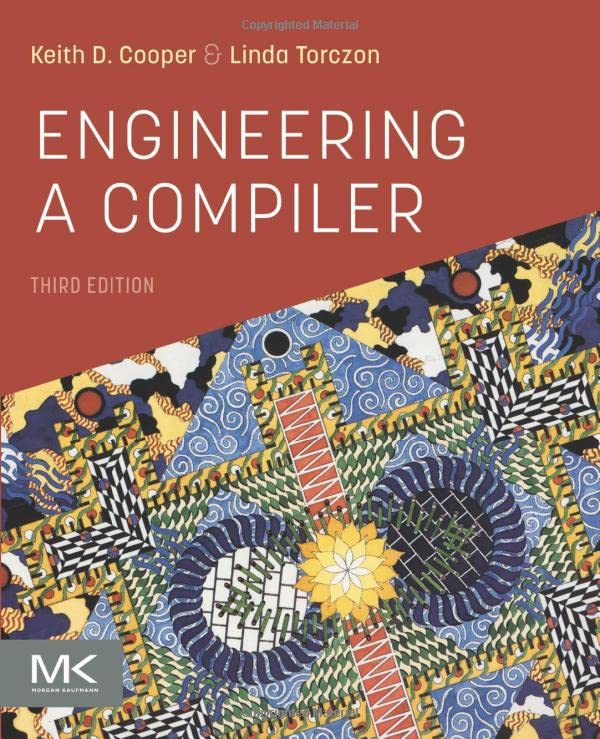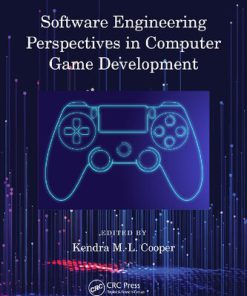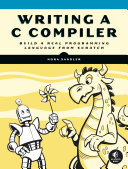Engineering a Compiler 3rd Edition by Keith D. Cooper 9780128189269 0128189266
$50.00 Original price was: $50.00.$25.00Current price is: $25.00.
Engineering a Compiler 3rd Edition Keith D. Cooper – Ebook Instant Download/Delivery ISBN(s): 9780128154120,0128154128, 9780128189269, 0128189266

Product details:
- ISBN 10: 0128189266
- ISBN 13: 9780128189269
- Author: Keith D. Cooper
Engineering a Compiler
Engineering a Compiler, Third Edition covers the latest developments in compiler technology, with new chapters focusing on semantic elaboration (the problems that arise in generating code from the ad-hoc syntax-directed translation schemes in a generated parser), on runtime support for naming and addressability, and on code shape for expressions, assignments and control-structures. Leading educators and researchers, Keith Cooper and Linda Torczon, have revised this popular text with a fresh approach to learning important techniques for constructing a modern compiler, combining basic principles with pragmatic insights from their own experience building state-of-the-art compilers.
- Presents in-depth treatments of algorithms and techniques used in the front end of a modern compiler
- Pays particular attention to code optimization and code generation, both primary areas of recent research and development
- Focuses on how compilers (and interpreters) implement abstraction, tying the underlying knowledge to students’ own experience and to the languages in which they have been taught to program
- Covers bottom-up methods of register allocation at the local scope
Table contents:
Chapter 1: Overview of Compilation
1.1. Introduction
1.2. Compiler Structure
1.3. Overview of Translation
1.4. Engineering
1.5. Summary and Perspective
Chapter Notes
Exercises
Bibliography
Chapter 2: Scanners
2.1. Introduction
2.2. Recognizing Words
2.3. Regular Expressions
2.4. From Regular Expression to Scanner
2.5. Implementing Scanners
2.6. Advanced Topics
2.7. Summary and Perspective
Chapter Notes
Exercises
Bibliography
Chapter 3: Parsers
3.1. Introduction
3.2. Expressing Syntax
3.3. Top-Down Parsing
3.4. Bottom-Up Parsing
3.5. Practical Issues
3.6. Advanced Topics
3.7. Summary and Perspective
Chapter Notes
Exercises
Bibliography
Chapter 4: Intermediate Representations
4.1. Introduction
4.2. An IR Taxonomy
4.3. Graphical IRs
4.4. Linear IRs
4.5. Symbol Tables
4.6. Name Spaces
4.7. Placement of Values in Memory
4.8. Summary and Perspective
Chapter Notes
Exercises
Bibliography
Chapter 5: Syntax-Driven Translation
5.1. Introduction
5.2. Background
5.3. Syntax-Driven Translation
5.4. Modeling the Naming Environment
5.5. Type Information
5.6. Storage Layout
5.7. Advanced Topics
5.8. Summary and Perspective
Chapter Notes
Exercises
Bibliography
Chapter 6: Implementing Procedures
6.1. Introduction
6.2. Background
6.3. Runtime Support for Naming
6.4. Passing Values Between Procedures
6.5. Standardized Linkages
6.6. Advanced Topics
6.7. Summary and Perspective
Chapter Notes
Exercises
Bibliography
Chapter 7: Code Shape
7.1. Introduction
7.2. Arithmetic Operators
7.3. Access Methods for Values
7.4. Boolean and Relational Operators
7.5. Control-Flow Constructs
7.6. Operations on Strings
7.7. Procedure Calls
7.8. Summary and Perspective
Chapter Notes
Exercises
Bibliography
Chapter 8: Introduction to Optimization
8.1. Introduction
8.2. Background
8.3. Scope of Optimization
8.4. Local Optimization
8.5. Regional Optimization
8.6. Global Optimization
8.7. Interprocedural Optimization
8.8. Summary and Perspective
Chapter Notes
Exercises
Bibliography
Chapter 9: Data-Flow Analysis
9.1. Introduction
9.2. Iterative Data-Flow Analysis
9.3. Static Single-Assignment Form
9.4. Interprocedural Analysis
9.5. Advanced Topics
9.6. Summary and Perspective
Chapter Notes
Exercises
Bibliography
Chapter 10: Scalar Optimization
10.1. Introduction
10.2. Dead Code Elimination
10.3. Code Motion
10.4. Specialization
10.5. Redundancy Elimination
10.6. Enabling Other Transformations
10.7. Advanced Topics
10.8. Summary and Perspective
Chapter Notes
Exercises
Bibliography
Chapter 11: Instruction Selection
11.1. Introduction
11.2. Background
11.3. Selection via Peephole Optimization
11.4. Selection via Tree-Pattern Matching
11.5. Advanced Topics
11.6. Summary and Perspective
Chapter Notes
Exercises
Bibliography
Chapter 12: Instruction Scheduling
12.1. Introduction
12.2. Background
12.3. Local Scheduling
12.4. Regional Scheduling
12.5. Advanced Topics
12.6. Summary and Perspective
Chapter Notes
Exercises
Bibliography
Chapter 13: Register Allocation
13.1. Introduction
13.2. Background
13.3. Local Register Allocation
13.4. Global Allocation via Coloring
13.5. Advanced Topics
13.6. Summary and Perspective
Chapter Notes
Exercises
Bibliography
Chapter 14: Runtime Optimization
14.1. Introduction
14.2. Background
14.3. Hot-Trace Optimization
14.4. Hot-Method Optimization
14.5. Advanced Topics
14.6. Summary and Perspective
Chapter Notes
Exercises
Bibliography
Appendix A: ILOC
A.1. Introduction
A.2. Naming Conventions
A.3. Computational Operations
A.4. Data Movement Operations
A.5. Control-Flow Operations
A.6. Opcode Summary Tables
Appendix B: Data Structures
B.1. Introduction
B.2. Representing Sets
B.3. IR Implementation
B.4. Implementing Hash Tables
B.5. A Flexible Symbol-Table Design
People also search:
engineering a compiler
engineering a compiler pdf
engineering a compiler 3rd edition pdf
engineering a compiler 3rd edition
engineering a compiler 2nd edition
You may also like…
History - American Studies
History - American Studies
American Civil War For Dummies 2nd Edition by Keith Dickson ISBN 1119863295 9781119863298
Medicine - Endocrinology
Medical Management of Thyroid Disease 3rd Edition David S. Cooper
Engineering - Civil & Structural Engineering
An Introduction to Geotechnical Engineering 3rd Edition Robert D. Holtz
Business & Economics - Others
Principles of Data Management Facilitating information sharing 3rd Edition Gordon Keith
Computers - Programming
Computers - Computer Science
Writing a C Compiler Early Access 1st Edition by Nora Sandler ISBN 9781718500433 1718500432
Engineering - Engineering - General & Miscellaneous












